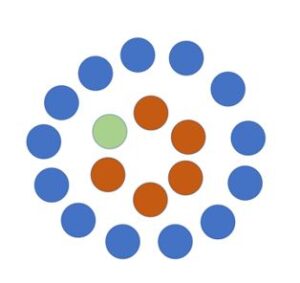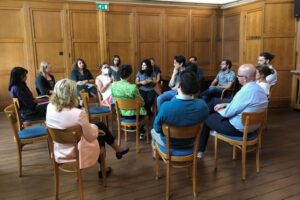What is the purpose of Higher Education?
By: Jan-Peter Sandler, Educative Master’s in Philosophy, Faculty of Social Sciences, KU Leuven-Belgium
At the STEAM+ international progress meet-up at the start of September, the steering group invited advisory board and policy partners for a morning filled with transdisciplinary inspiration. The day started off with a speed date to get to know each other better and we came up with a catchy slogan for the STEAM+ project. A tough competition of great slogan suggestions ended in a draw between three super slogans:
- Catching talent today to co-create the world tomorrow
- Transdisciplinarity for a sustainable future
- Dare to go beyond the knowledge boundaries

After the speed date all visitors sat together in a fishbowl. An exercise on active listening and speaking. The setup of the bowl is simple. There are two circles with the speakers in a small circle on the inside and a larger circle of listeners around them. In this fishbowl one chair was open on the inside for listeners to step in.
The starting question of the fishbowl was “What is the purpose of Higher Education?” a question also asked by Rachel Brooks and her colleagues in Students’ views about the purpose of higher education: a comparative analysis of six European countries, (Brooks et al., 2021).
First to sit in the middle and start the discussion were five very brave and highly talented students with very diverse educational backgrounds from the Transdisciplinary Insights Honours Programme (TDI). An opportunity for them to share their points of view with policy partners and teachers who were attentively listening on the outside.

After a half hour, the discussion was stopped to make time for reflection. The participants sat together in small groups for a few minutes to reflect upon something that caught their attention during the discussion.
An exercise like this with policy makers, teachers and students allows a space for deeper insights and broadening horizons. In this case it became apparent that students have many different interests within higher education (HE) such as preparing for their future careers, further exploring their interests or to secure their futures.
I was happily surprised with the receptiveness of all participants for the diverse opinions and ideas that were discussed. The discussion was lively and allowed for students to really engage with those who structure their education.
Often a simple discussion between the right people creates a fertile ground for transformation. The fishbowl allowed for a safe space to bring together different stakeholders of HE in a level playing field and share their own perspectives. Discussions like these between students, teachers, the HE institute’s policy representatives and policy makers are crucial if we are to transform HE and implement transdisciplinary programs.
The students who participated in the fishbowl created a vlog where they shared their own reflections after taking part in TDI and this fishbowl exercise. They asked each other three questions:
- What insights did you gain from the fishbowl exercise ?
- What’s the benefit of fishbowl exercise?
- What’s your reflection/take on transdisciplinary education?
See the video to find out what they had to say !
References:
Rachel Brooks, Achala Gupta, Sazana Jayadeva & Jessie Abrahams (2021) Students’ views about the purpose of higher education: a comparative analysis of six European countries, Higher Education Research & Development, 40:7, 1375-1388, DOI: 10.1080/07294360.2020.1830039
